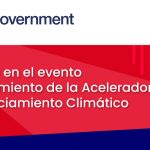How cost-effective is it to decarbonize our economy?

[Opinion] It's time to decarbonize the economy
The Sixth Assessment Report of the Intergovernmental Panel on Climate Change (IPCC) has confirmed what was an open truth: human action has warmed the planetThe climate crisis is here, and the breach of the "safe" limit of temperature increase could come in a little more than a decade. The climate crisis is here, and the breach of the "safe" limit of temperature increase could come in little more than a decade.
The window of opportunity for not exceeding the global temperature increase limit of 1.5°C still exists, but it will close quickly. We have a few years to move from "marginal improvements" to "drastic changes". We need a plan. Halve emissions by 2030, get to net zero emissions by 2050, or sooner.
According to the study, Peru will experience more droughts and fires, with potential impacts on agriculture, forests, health and ecosystems. The melting of Andean glaciers will continue to affect water resources. In other areas, the intensity and frequency of extreme precipitation and flooding events are expected to increase.
Efforts to build institutions, a regulatory framework, and capacities to address climate change are on the right track, but we need to accelerate action to adapt and decarbonize our economy before 2050. At the business level, this implies more profound changes than adopting telework on a permanent basis or reducing fossil fuel consumption. The recent COVID-19 challenge shows us not only the impact that an inappropriate relationship with nature can trigger, but also the importance of strengthening coping mechanisms and innovating.
In Peru, we must promote at least four "drastic changes over the next 10 years:
1) All public and private infrastructure that we develop must consider the following climate change scenarios generated by SENAMHI.
2) We must significantly scale up investment in the conservation, regeneration and sustainable management of our ecosystems, to offer nature-based solutionsemissions, such as carbon sequestration in forests and oceans.
3) Transitioning to a electrified economyThe plant is largely supplied by renewable energy.
4) And to promote the approach of circular economy.
All these changes could contribute to post-COVID economic recovery, in terms of job and income generation. An IDB study shows that achieving carbon neutrality by 2050 could bring US $$140 billion in net benefits in Peru.
All these changes require good public policies, an innovative private sector and an informed citizenry. We cannot let this opportunity pass us by.

Pia Zevallos
Founding partner of Libélula and director of the Climate Change Management Support Project.
Originally published in:
← Previous
Next →
Stay up to date
Receive a summary of the most relevant news about companies and sustainability. Every month, free of charge!


